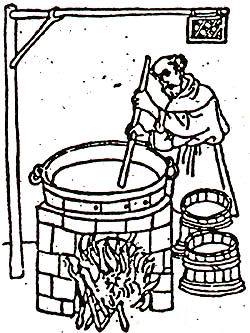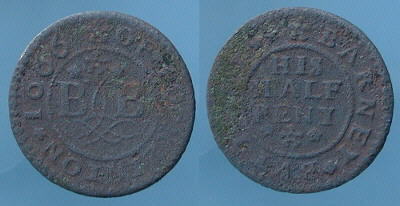|
 Ale has been around for centuries, and had almost certainly arrived in Britain by the Neolithic period. The Romans introduced wine and the Normans brought cider, but ale still prevailed. Ale was particularly popular in Anglo-Saxon times when the first drinking halls were set up, and ale was brewed and served by women. The word 'Ale' is of Viking origin. Shared drinking vessels were used and each person’s quota was marked by a peg – hence the old phrase ‘to down a peg or two.’ Ale has been around for centuries, and had almost certainly arrived in Britain by the Neolithic period. The Romans introduced wine and the Normans brought cider, but ale still prevailed. Ale was particularly popular in Anglo-Saxon times when the first drinking halls were set up, and ale was brewed and served by women. The word 'Ale' is of Viking origin. Shared drinking vessels were used and each person’s quota was marked by a peg – hence the old phrase ‘to down a peg or two.’
Originally beer ale was brewed in the home, on the farm, and most notably in monasteries. Special brews were made to give away at church festivals. It was called 'Scot Ales' – hence ‘scot free’. A new type of ale arrived from the Low Countries in the 15th C. Flavoured by hops it was called beer. By the end of the century had become more popular than ale, and half of England’s North Sea exports to the Continent were barrels of beer. It was the staple drink in Tudor times. Henry VIIs ladies in waiting were given a breakfast allowance of a gallon of beer. Children started to drink beer at the age of three months.
Pre 1400: Ale was made with water, malted barley and yeast.
After 1400: Beer – water, malted barley, hops & yeast.
Pocklington became a centre of brewing and malting from Medieval times. It had ample supplies of water from its streams and springs, and more importantly it's clay soils were renowned for quality malting barley. The clay lands around Pocklington have continued to produce top quality  malting barley right up to the present day. Pocklington is known to have been growing corn since at least the bronze age, with a flint sickle dating to 2,000 BC being found at Pocklington school which was used to separate grains of corn from their stalk. malting barley right up to the present day. Pocklington is known to have been growing corn since at least the bronze age, with a flint sickle dating to 2,000 BC being found at Pocklington school which was used to separate grains of corn from their stalk.
Early references – 13th & 14th century
Extent of the manor of Pockelington.
Writ dated at Westminster, 1 August 1260 shows feudal service was demanded by the lord of the manor in return for food and ale. “The works of the said sokemen are these: Each one ought to plough once in winter before Christmas-day, according to the plough which he has. He ought also to plough once in spring in the same manner. The ploughmen ought to have to eat, wheaten-bread and flesh, and ale to drink in winter, while they have day, in spring wheaten-bread and fish to eat, and ale to drink, during their day's work.”
Account rolls of the Seignory of Holderness (started in 1260 by Remigius de Pokelington, Sheriff of Holderness) list in 1266 the price of “Pocklington barley at 4/- (20p) a quarter.”
Meaux Chartulary 1300 (The Abbot of Meaux was Lord of the Manor of Pocklington) indicates that ale was brewed in Pocklington and sold at the weekly market. Anyone selling ale that was not to the required 'Assize of Ale' standard was punished by being put in the tumbril (a type of stocks).
'The Abbat of Melsa complained of Roger son of Remigius de Pokelington and others, for forcibly throwing down a tumbril which had from ancient times been used in the execution of breaches of the assizes of bread and ale within the Abbat's manor of Pokelyngton.' (The Assize of Bread and Ale was a 1266 statute, which regulated the price, weight and quality of the bread and beer manufactured and sold in towns, villages and hamlets. It was the first law in British history to regulate the production and sale of food and drink).
15th & 16th century references.
Malt donations in the will of Robert Asshe 1494: The 1494 donation of a quarter of malt by Robert Asshe to both the Apostles Gild and the St Mary Gild indicates that malting was an established business in the town and the guild organisations may have brewed beer to give to members or the town’s poor.
Henry Percy’s Household Book 1512: The Northumberland Household Book 1512. The regulations and establishment of the houshold of Henry Algernon Percy. By Henry Algernon Percy (5th earl of Northumberland) of Leconfield & Wressle, Lord of the Manor of Pocklington 1489-1527.
The Yoman Officir of the Ridynge Householde (57 staff) included - The Yoman Brewer who doth attend in the Brewhous for Brewing daily when they brew. A child of the Brewhous who doth attend in the Brewhous for Brewing daily when they brew. A Groim Mylner who atends hourely in the Mylne for Grynding of corn for Baiking and Brewing for my Lordis Hous. It is odered ande agreed by my Lorde that there shall by vi Quarters of Malt brewed at every brewing in my Lords House thrughoute the Yere. In Winter xii Hoggesheds (a Hogshead = 54 gallons) And in Somer xi Hoggesheds Bicaus the said beere must be made bigger in Somer than Winter for turnynge. Of Ale vii after iid the gallon = xiiid. Of beire xiii hogsheds after the gallon = xliiis vid.
'Big' and 'Small' beer (i.e. stronger and weaker brews) continued locally as a description into the 20th century. Farmers and farm labourers were given small beer in the fields at harvest (one old farmer stated that small beer cost 3 old pence a gallon circa 1900).
John Dolman’s will 1525: Famous Pocklingtonian, John Dolman, left monies to provide ale and cheese for the poor.
Survey of the Monasteries 1535: Henry VIIIs survey of the monasteries in preparation for their dissolution lists substantial brewhouses at Wilberfoss and Warter priories.
‘Agricultural Markets & Trade 1500-1750’ (Cambridge University Press 1990) lists Pocklington as one of the top 25 corn markets in the North of England.
16th Century References
The probate inventory of William Rideard 1551, yeoman, malster & brewer (Pocklington’s fourth richest citizen from the 1540 & 1545 tax lists and for a time Henry VIIIs bailiff for the manor of Pocklington) details his property,
a brewhouse, beer store, malt kiln and granary. Brewhouses were commonly called gill or gyll houses. “in the parlour... in the chamber above the parlour... in the madyns chamber... the Haull... the chambers above the haull... in the gyll house (brewhouse)... in the buttery (wine/beer store)... in the low buttery (pantry/food store)... in the kitchinge... in the garner and laithe (granary)... in the kilne (chamber for drying malt)... in the garthe (garden / yard).”
Other 16th & 17th century references
1552: A court case in York records James Illerson of Pocklington offering his malt for sale at 12 shillings a sack.
1560-1645: Henry Best’s Farming & Memoranda books describe the East Riding’s top corn markets – Bridlington for oats, Malton for wheat & Pocklington for barley.
1586: William Sanderson, maltman.
1588. William Wood, Pocklington, maltman, made his will, his body to be buried in ye church of Pocklington, near his seat.
1594. William Lodie, Pocklington, maltman, to be buried "near his stall."

1669: Barney Buttery, maltman. Lived in a big house with 9 rooms and left £223. His 'trade tokens' still exist and are popular with token and coin collectors.
1690: "The tipling Malster Jasper Belt": Belt was a local malster, brewer and publican, from an influential local gentry family (his father was Sir Robert Belt of Bossall, a former Lord Mayor of York) and had extensive estates around the town. Belt the "Incendiary to ourTinder Tappe houses." led the campaign to have the headmaster of Pocklington School, Roland Greenwood, dismissed in the 1650s. His complaint was that Greenwood had run the school down and it only had a handful of puplis - in the early days of the school boarders traditionally lived in the town's inns and the will inventory of several publicans note their premises had 'scholar's chambers'. Jasper also came to a subsequent sticky end when he was murdered in 1690 by being stabbed in the neck by a joiner with a pair of carpenter’s compasses.
The Constables of Everingham household records list beer bought from Pocklington.
18th century references:
1737: Thomas Houlden, of Pocklington, malster. Also in 1737 there were five cases before the East Riding Quarter Sessions for the theft of barley at Pocklington (three men and two women).
1752: Timothy Overend, of Pocklington, brewer & publican
1756 – Pocklington is listed as having 32 alehouses. The town had a population of approximately 900. Many of the ale houses brewed their own beer.
In the following year, September 1757, 1,500 rioters spent the night in Pocklington’s hostelries and the next day marched to besiege Kilnwick Percy Hall. They eventually broke into the hall but were kept at bay from raiding the cellars for wine and beer by Lady Anderson, and the rioters dispersed when Sir Edmund Anderson arrived soon after.
1756: Richard Cross, of Pocklington, brewer.
1769: William Watts, of Pocklington, brewer.
1781: John Smith, of Pocklington, malster.
1795: Thomas Staveley, of Pocklington, common brewer.
|

